A volcano wakes up
Earthquakes, small eruptions, and a new lava dome unsettle Mount St. Helens.
After resting for nearly 2 decades, Mount St. Helens woke up this fall. Shaking ground and a skyward blast proved to the world that it’s still an active volcano.
Tiny earthquakes had been shaking the mountain for a week before it erupted on Oct. 1, 2004. The volcano spewed a gray plume of steam and ash 10,000 feet into the air. Hot magma began oozing out of the crater a few weeks later. As it kept coming, the magma literally built a small mountain in front of scientists’ eyes.
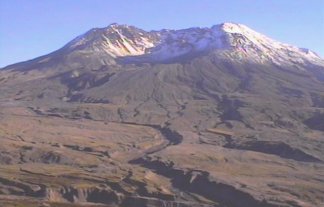 |
|
Mount St. Helens on a quiet day this fall, just before it spewed steam and ash into the air on Oct. 1, 2004.
|
| Forest Service, U.S. Department of Agriculture |
These events weren’t as explosive as the massive eruption that blew the top off the mountain in 1980. But the recent activity at Mount St. Helens has kept scientists busy making observations and trying to guess what comes next.
“All of us geologists are curious to see what’s going to happen,” says Tom Pierson. He’s a research geologist with the U.S. Geological Survey.
Making a volcano
Mount St. Helens is in Washington State. It’s part of the Cascade Mountain Range, which stretches from British Columbia in Canada to northern California.
Mountains in the Cascades formed where two big chunks of Earth’s crust, called plates, ran into each other. When the plate under the Pacific Ocean pushed beneath the plate under North America, the incredibly high pressure and temperature caused rocks to melt into a gooey, superheated magma. The magma then seeped up through the crust. Occasionally, it reached the surface, creating volcanoes.
On the morning of May 18, 1980, Mount St. Helens demonstrated this ongoing process. The mountain erupted, sending ash more than 15 miles into the sky. The blast also went outwards, blowing out the north face of the mountain. This outburst caused massive landslides and leveled trees for miles. Lasting for 9 hours, the eruption killed fifty-seven people.
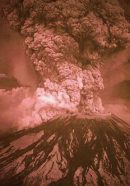 |
|
Mount St. Helens erupted on May 18, 1980, sending an enormous plume of ash into the sky.
|
| Austin Post, U.S. Geological Survey |
Over the next 6 years, there were some small eruptions. At times, magma seeped out of the crater, creating a lava dome. Then, except for a few minor outbursts, all was pretty quiet on Mount St. Helens for about 18 years.
Puzzling earthquakes
When a swarm of small earthquakes started up in late September, it puzzled geologists. On Mount St. Helens, earthquakes usually mean that fresh magma filled with expanding gases is pushing toward the surface, shoving rocks aside.
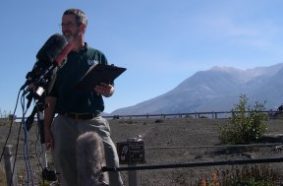 |
|
Tom Pierson, geologist and volcano watcher, explains what’s going on at Mount St. Helens to reporters.
|
| Kate Ramsayer |
Scientists can detect these gases, including sulfur dioxide and carbon dioxide, using a special airplane that collects air samples. But when they made flights early this fall, the air didn’t have unusual amounts of the gases.
This would normally suggest that old magma was triggering the earthquakes. Like a flat soda, this magma would have already lost its gas, and the volcano probably wouldn’t erupt explosively.
But the earthquakes became more frequent and stronger as time went on. Altogether, they released more energy than had been released since the 1980 eruption. This didn’t fit with the old-magma hypothesis, Pierson says.
So geologists came up with a new hypothesis. Maybe fresh magma was causing the ruckus on Mount St. Helens. But airplanes couldn’t detect any released gas because it was being absorbed by the crater’s glacier.
Then seismographs, which record ground movements, detected something called a harmonic tremor. A harmonic tremor is a slow vibration of the ground. It’s a bit like the rattling sound you sometimes hear when water flows through pipes, Pierson says.
This ground motion told scientists that fresh magma was definitely on the move.
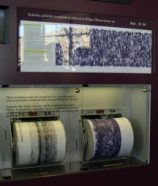 |
|
Seismographs record ground movements.
|
| Kate Ramsayer |
“Each one of these tremor events means the magma moved a little further,” says Jim Vallance. He’s a research geologist with the Cascades Volcano Observatory and the U.S. Geological Survey.
The increasing tremors and moving magma indicated that an eruption could occur within 24 hours of the first blast. On Oct. 2, scientists and park rangers with the U.S. Forest Service decided to move hundreds of volcano watchers back for safety.
“When you see a really strong tremor, it’s a good time to give the volcano a little room,” Bill Steele says. He’s the seismic laboratory coordinator at the Pacific Northwest Seismograph Network at the University of Washington.
However, nothing happened that weekend, showing that nobody can predict exactly what a volcano might do. Since then, the mountain has released several, small plumes of steam and ash.
A new dome
Many scientists are now excited about the creation of a new lava dome in the crater of Mount St. Helens. Since mid-October, magma has been breaking through the surface at a rate of about 7 or 8 cubic yards per second.
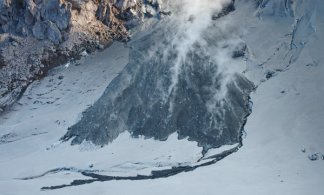 |
|
A new lava dome is forming in the crater of Mount St. Helens.
|
| U.S. Geological Survey |
“That’s like having a dump truck or cement mixer full of magma ejected every second onto the dome,” Steele says. “It’s pretty phenomenal.” Scientists can practically watch a mountain being built right before their eyes.
Will the dome continue to grow, or will the volcano take another rest? That’s the big question, says Willie Scott of the U.S. Geological Survey. There’s no reliable way for geologists to predict what a volcano will do.
“All we can do is monitor it closely and see if indeed it’s dying down or if it’s changing its behavior,” Scott says. “There’s no cookbook that tells us that, if we see this, this will happen.”
Scientists have several ways to keep an eye on the volcano. They can measure the gases that the volcano releases. These measurements give them clues about the magma beneath the surface.
They can use seismographs to track earthquakes, which have quieted down since the magma forged a path to the surface. Although the first eruption this fall destroyed some instruments, others have been slung into place on the crater by helicopter to measure the shaking.
Geologists can also look for changes in the shape and size of the mountain. They can look for hotspots on the crater by detecting the heat given off by the surface. They can collect rocks to study the magma itself.
Quick trips
Most of the monitoring equipment is placed in the crater by helicopter. A few times, however, scientists have made very quick trips to the crater floor to take samples or set up instruments. They don’t linger, though, because they don’t want to be there if the volcano erupts!
Still, scientists want to be able to detect any changes in the mountain that could signal danger. The new dome is unstable. If it collapses and clogs the magma flow, the pressure could build up and lead to an eruption. Ash in the air could cause problems for nearby airplanes. Mudslides or floodwaters from a melted glacier could harm people near the mountain.
“Any volcano surprises the people who are studying it,” Pierson says. It pays to pay attention.
Going Deeper:
News Detective: Observing a Volcano
Mount St. Helens Facts
Elevation: 2,549 meters (8,363 feet)
Earliest eruption: 10,000 years ago
Oldest historic eruption: 1831
Number of eruptions in 20th century: 5
Notable feature: In 1980, a sideways blast removed the upper 396 meters (1,306.8 feet) of the volcano.
Notable statistic: The 1980 blast devastated 596 square kilometers (229 square miles) and destroyed timber valued at several million dollars.
Fatalities: Most of the 57 people killed in the 1980 eruption choked to death. The hot gases scorched their lungs.
Source: National Oceanic and Atmospheric Administration







